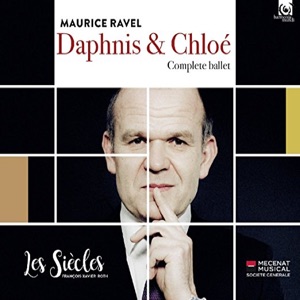This is a light, lively performance of Daphnis et Chloé based on a completely false premise. It could not be less atmospheric. The chorus sounds small, young, bright, and much too forwardly balanced, making nonsense out of its theoretically spooky interlude or the Apparition of Pan episode. Conductor François-Xavier Roth gets the undersized string section to phrase in a choppy, “period” style possibly more suited to Vivaldi, and it becomes bothersome right from the opening Danse religieuse. Everything else sounds basically as it would today, and despite some brisk tempos there’s nothing especially balletic about it.
The false premise mentioned above stems from the idea that by using “instruments of the period” the interpretation can lay claim to some degree of “authenticity”. Daphnis premiered in 1912. There was nothing about orchestral performance in 1912 so different from, say, 1950, or 2000, that it would have superseded the audible differences between orchestras and interpreters from one performance to the next. Nothing. The period-instrument crowd can whine all it likes about vibrato, or string portamento, or small bore brass, or catgut and what have you, but all they are doing is exaggerating the significance of trivial details and exalting mechanism over artistry.
This is particularly obvious in the case of a work like Daphnis. The conductor of that 1912 premiere was Pierre Monteux, who lived to make an absolutely splendid stereo recording of the score for Decca nearly half a century later. If anyone knew about “authenticity” in this particular work, it was Monteux. There is no sound that these players make that a normal orchestra could not make on demand. So listen to the sounds that Monteux demands, and compare them to this. Is it vastly different? No, not really, but the differences that do exist stem not from the authenticity of period timbres, accent, or phrasing, but from using too few strings alongside an entirely modern (and largely specious) view of what those qualities ought to be.
This performance, then, is a contemporary copy of a theoretical antique, a forgery in a sense, and it has about as much value. It isn’t terrible by any means, but it deserves to be judged based on what it claims to be. Why waste your time with it when Monteux is readily available and you can still enjoy the real thing?
































